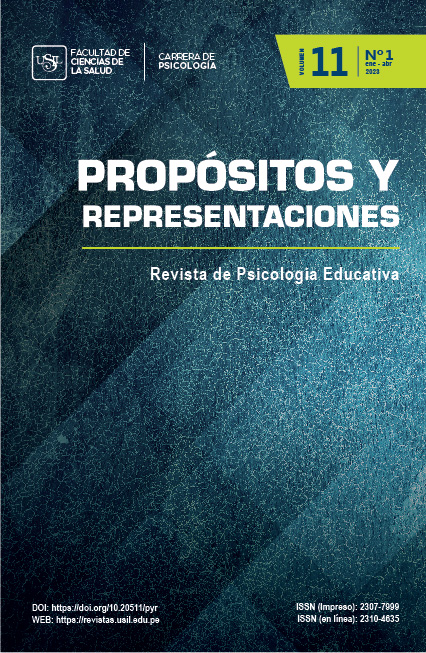Estrategias cognitivas y de autorregulación, engagement académico y rendimiento académico en estudiantes del nivel superior. El rol mediador de la comprensión lectora
Cognitive and Self-regulation Strategies, Academic Engagement and Academic Achievement in Higher Education Students. The Mediating Role of Reading Comprehension
##plugins.themes.bootstrap3.article.main##
El objetivo del presente estudio fue examinar la relación entre las estrategias cognitivas y de autorregulación, el engagement académico y el rendimiento académico (RA) en estudiantes del nivel superior, analizando el rol mediador de la comprensión lectora. Se administraron diferentes tareas para evaluar los constructos a 209 estudiantes (Medad = 21.71; DE = 4.36). Para valorar el rendimiento académico se empleó el promedio académico de los estudiantes. Se hallaron asociaciones significativas entre las estrategias cognitivas y de autorregulación, el engagement académico, la comprensión lectora y el rendimiento académico de los estudiantes. Además, se observó una correlación entre las estrategias cognitivas y de autorregulación y el engagement académico del estudiante. Finalmente, el análisis de ecuaciones estructurales (SEM) mostró que las estrategias cognitivas y de autorregulación y el engagement académico tienen efectos directos en el RA. Además, se observó un efecto indirecto de las estrategias cognitivas y de autorregulación en el RA a través de la comprensión lectora. Se discuten las implicaciones del estudio en función de la relevancia de promover el reconocimiento e implementación de las propias estrategias cognitivas y metacognitivas y el engagement del estudiante, para favorecer su desempeño académico en el nivel superior.
##plugins.themes.bootstrap3.article.details##
Alegre, A. (2014). Academic self-efficacy, self-regulated learning and academic performance in first-year university students. Propósitos y Representaciones, 2(1), 79-120. https://doi.org/10.20511/pyr2014.v2n1.54
Alrashidi, O., Phan, H. P., & Ngu, B. H. (2016). Academic engagement: an overview of its definitions, dimensions, and major conceptualisations. International Education Studies, 9(12), 41-52. https://doi.org/10.5539/ies.v9n12p41
Arán-Filippetti, V., & Krumm, G. (2020). A hierarchical model of cognitive flexibility in children: Extending the relationship between flexibility, creativity and academic achievement. Child Neuropsychology, 26, 770-800. https://doi.org/10.1080/09297049.2019.1711034
Arán-Filippetti, V., & López, M. B. (2016). Funciones ejecutivas y comprensión lectora. Cuadernos de Neuropsicología, 10(1), 23-44. https://doi.org/10.7714/CNPS/10.1.202
Arbuckle, J. L. (2007). Amos 16.0 user’s guide. Amos Development Corporation.
Arias-Gundín, O., Fidalgo, R., & Robledo, P. (2012). Metacognición y comprensión lectora: conocimiento y uso de estrategias. International Journal of Developmental and Educational Psychology, 2(1), 195-201. https://hdl.handle.net/10662/2709
Bastug, M. (2014). The structural relationship of reading attitude, reading comprehension and academic achievement. International Journal of Social Sciences and Education, 4(4), 931-946. https://ijsse.com/sites/default/files/issues/2014/v4-i4-2014-1/Paper-20.pdf
Bharuthram, S. (2012). Making a case for the teaching of reading across the curriculum in higher education. South African Journal of Education, 32, 205-214
Becker, D. R., Miao, A., Duncan, R., & McClelland, M. M. (2014). Behavioral self-regulation and executive function both predict visuomotor skills and early academic achievement. Early Childhood Research Quarterly, 29(4), 411-424. https://doi.org/10.1016/j.ecresq.2014.04.014
Boekaerts, M. (2016). Engagement as an inherent aspect of the learning process. Learning and Instruction, 43, 76-83. https://doi.org/10.1016/j.learninstruc.2016.02.001
Botsas, G., & Padeliadu, S. (2003). Goal orientation and reading comprehension strategy use among students with and without reading difficulties. International Journal of Educational Research, 39, 477-495. https://doi.org/10.1016/j.ijer.2004.06.010
Castañeda, S., Pérez, I., & Peña, R. (2016). Validación de constructo de componentes de agencia académica evaluados en web. Revista de Investigación en Psicología, 19(2), 9-24. https://doi.org/10.15381/rinvp.v19i2.12887
Casuso-Holgado, M. J., Cuesta-Vargas, A. I., Moreno-Morales, N., Labajos-Manzanares, M. T., Barón-López, F. J., & Vega-Cuesta, M. (2013). The association between academic engagement and achievement in health sciences students. BMC Medical Education, 13(1), 1-7. https://doi.org/10.1186/1472-6920-13-33
Chavez, A., & Vallejos-Flores, M. A. (2021). Diseño y validez de la Escala de Adicción a Instagram de Bergen (BIAS) en adultos peruanos. Propósitos y Representaciones, 9(1), e973. https://doi.org/10.20511/pyr2021.v9n1.973
Difabio, H. (2008). El test cloze en la evaluación de la comprensión del texto informativo de nivel universitario. RLA. Revista de lingüística teórica y aplicada, 46(1), 121-137. https://www.scielo.cl/scielo.php?script=sci_arttext&pid=S0718-48832008000100007
Elvira-Valdés, M. A., & Pujol, L. (2012). Autorregulación y rendimiento académico en la transición secundaria-universidad. Revista Latinoamericana de Ciencias Sociales, Niñez y Juventud, 10(1), 367-378. https://revistaumanizales.cinde.org.co/rlcsnj/index.php/Revista-Latinoamericana/article/view/612
Ernst, C., Arán Filippetti, V., & Lemos, V. (2022). Estrategias de aprendizaje y rendimiento académico: revisión sistemática en estudiantes del nivel secundario y universitario. Uniandes Episteme, 9(4), 534-562. http://45.238.216.13/ojs/index.php/EPISTEME/article/view/2737/2224
Estévez, I., Rodríguez-Llorente, C., Piñeiro, I., González-Suárez, R., & Valle, A. (2021). School engagement, academic achievement, and self-regulated learning. Sustainability, 13(6), 3011. https://doi.org/10.3390/su13063011
Fechheimer, M., Webber, K., & Kleiber, P. B. (2011). How well do undergraduate research programs promote engagement and success of students?. CBE-Life Sciences Education, 10(2), 156-163. https://doi.org/10.1187/cbe.10-10-0130
Finn, J. D. (1989). Withdrawing from school. Review of Educational Research, 59, 117-142. https://doi.org/10.3102/00346543059002117
Fredricks, J. A., Blumenfeld, P. C., & Paris, A. H. (2004). School engagement: Potential of the concept, state of the evidence. Review of Educational Research, 74(1), 59-109. https://doi.org/10.3102/00346543074001059
García-Madruga, J. A., Vila, J. O., Gómez-Veiga, I., Duque, G., & Elosúa, M. R. (2014). Executive processes, reading comprehension and academic achievement in 3th grade primary students. Learning and Individual Differences, 35, 41-48. https://doi.org/10.1016/j.lindif.2014.07.013
Gaxiola, J. C., Lugo, S., & Gaxiola, E. (2013). Autorregulación, resiliencia y metas educativas: variables protectoras del rendimiento académico de bachilleres. Revista Colombiana de Psicología, 22(2), 241-252. http://www.scielo.org.co/pdf/rcps/v22n2/v22n2a02.pdf
Gómez H., P., Pérez, V. C., Parra, P. P., Ortiz, M. L., Matus, B. O., McColl, C. P., ... & Meyer, K. A. (2015). Relación entre el bienestar y el rendimiento académico en alumnos de primer año de medicina. Revista Médica de Chile, 143(7), 930-937. https://doi.org/10.4067/S0034-98872015000700015
Gunuc, S. (2014). The relationships between student engagement and their academic achievement. International Journal on New Trends in Education and Their Implications, 5(4), 216-231. http://ijonte.org/FileUpload/ks63207/File/19..gunuc.pdf
Gutierrez-Braojos, C., & Salmerón, H. (2012). Estrategias de comprensión lectora para estudiantes de primer grado de educación primaria. Profesorado: Revista de Currículum y Formación del Profesorado, 6(1), 183-202. https://hdl.handle.net/10481/23007
Heng, K. (2014). The relationships between student engagement and the academic achievement of first-year university students in Cambodia. The Asia-Pacific Education Researcher, 23(2), 179-189. https://doi.org/10.1007/s40299-013-0095-8
Hernández-Sampieri, R., & Mendoza, C. (2020). Metodología de la investigación: las rutas cuantitativa, cualitativa y mixta. Mcgraw-Hill.
Hofmann, W., Schmeichel, B. J., & Baddeley, A. D. (2012). Executive functions and self-regulation. Trends in Cognitive Sciences, 16(3), 174-180. https://doi.org/10.1016/j.tics.2012.01.006
Hughes, R., & Pace, C. R. (2003). Using NSSE to study student retention and withdrawal. Assessment Update, 15(4), 1-2.
Hu, L., & Bentler, P. M. (1995). Evaluating model fit. In R. H. Hoyle (Ed.), Structural equation modeling: concepts, issues, and applications (pp. 76-99). Sage.
Hu, L., & Bentler, P. M. (1999). Cutoff criteria for fit indexes in covariance structure analysis: Conventional criteria versus new alternatives. Structural Equation Modeling: A Multidisciplinary Journal, 6(1), 1-55. https://doi.org/10.1080/10705519909540118
Kohler, J. L. (2013). Rendimiento académico, habilidades intelectuales y estrategias de aprendizaje en universitarios de Lima. Liberabit, 19(2), 277-288. http://www.scielo.org.pe/pdf/liber/v19n2/a13v19n2
Lei, H., Cui, Y., & Zhou, W. (2018). Relationships between student engagement and academic achievement: A meta-analysis. Social Behavior and Personality: an International Journal, 46(3), 517-528. https://doi.org/10.2224/sbp.7054
Li, S., & Lajoie, S. P. (2021). Cognitive engagement in self-regulated learning: an integrative model. European Journal of Psychology of Education (IF2.663). https://doi.org/10.1007/S10212-021-00565-X
Martín, E., García, L. A., Torbay, Á., & Rodríguez, T. (2008). Estrategias de aprendizaje y rendimiento académico en estudiantes universitarios. International Journal of Psychology and Psychological Therapy, 8(3), 401-412. https://www.ijpsy.com/volumen8/num3/213/estrategias-de-aprendizaje-y-rendimiento-ES.pdf
McClelland, M. M., & Cameron, C. E. (2011). Self‐regulation and academic achievement in elementary school children. New Directions for Child and Adolescent Development, 2011(133), 29-44. https://doi.org/10.1002/cd.302
McKeachie, W. J., Pintrich, P. R., Lin, Y. G., & Smith, D. (1986). Teaching and learning in the college classroom: A review of the research literature. Ann Arbor: National Center for Research to Improve Postsecondary Teaching and Literacy, The University of Michigan. https://files.eric.ed.gov/fulltext/ED314999.pdf
Medrano, L. A., Moretti, L., & Ortiz, A. (2015). Medición del engagement académico en estudiantes universitarios. Revista Iberoamericana de Diagnóstico y Evaluación-e Avaliação Psicológica, 2(40), 114-124. https://www.redalyc.org/pdf/4596/459645432012.pdf
Mesurado, B., Richaud, M. C., & José Mateo, N. (2016). Engagement, flow, self-efficacy, and eustress of university students: A cross-national comparison between the Philippines and Argentina. The Journal of Psychology, 150(3), 281-299. https://doi.org/10.1080/00223980.2015.1024595
Moje, E. B., Stockdill, D., Kim, K., & Kim, H. J. (2011). The role of text in disciplinary learning. In M. L. Kamil, P. D. Pearson, E. B. Moje, & P. P. Afflerbach (Eds.), Handbook of reading research (Vol. IV, pp. 453-486). Routledge.
Morrison, F. J., Ponitz, C. C., & McClelland, M. M. (2010). Self-regulation and academic achievement in the transition to school. In S. D. Calkins & M. A. Bell (Eds.), Child development at the intersection of emotion and cognition (pp. 203-224). American Psychological Association. https://doi.org/10.1037/12059-011
Nejabati, N. (2015). The effects of teaching self-regulated learning strategies on EFL students' reading comprehension. Journal of Language Teaching and Research, 6(6), 1343-1348. https://doi.org/10.17507/jltr.0606.23
Northey, G., Govind, R., Bucic, T., Chylinski, M., Dolan, R., & van Esch, P. (2018). The effect of “here and now” learning on student engagement and academic achievement. British Journal of Educational Technology, 49(2), 321-333. https://doi.org/10.1111/bjet.12589
Oliveira, K. L., & Dos Santos, A. A. A. (2006). Compreensão de textos e desempenho acadêmico. PSIC Revista de Psicología da Vetor Editora, 7(1), 19-27. http://pepsic.bvsalud.org/pdf/psic/v7n1/v7n1a04.pdf
Peralbo, M., Porto, A., Barca, A., Risso, A., Mayor, M. A., & García, M. (2009). Comprensión lectora y rendimiento escolar: cómo mejorar la comprensión de textos en secundaria obligatoria. In Actas do X Congresso Internacional Galego-Português de Psicopedagogia (pp. 4127-4142). Braga: Universidade do Minho. https://www.educacion.udc.es/grupos/gipdae/documentos/congreso/xcongreso/pdfs/t9/t9c305.pdf
Pinto, N. S., Martínez, A. I. M., & Jiménez-Taracido, L. (2016). Learning strategies, reading comprehension and academic achievement in Secondary Education. Psicologia Escolar e Educacional, 20(3), 447-456. https://doi.org/10.1590/2175-3539201502031101
Pretorius, E. J. (2002). Reading ability and academic performance in South Africa: Are we fiddling while Rome is burning? Language Matters, 33(1), 169-196. https://doi.org/10.1080/10228190208566183
Schaufeli, W. B., Salanova, M., González-Romá, V., & Bakker, A. B. (2002). The measurement of engagement and burnout: A two sample confirmatory factor analytic approach. Journal of Happiness Studies, 3, 71-92.
Serrano, C., Andreu, Y., Murgui, S., & Martínez, P. (2019). Psychometric properties of Spanish version student Utrecht Work Engagement Scale (UWES-S-9) in high-school students. The Spanish Journal of Psychology, 22. https://doi.org/10.1017/sjp.2019.25
Soper, D. (2020). A-priori Calculadora de tamaño de muestra para modelos de ecuaciones estructurales 2020. Free Statistics Calculators. https://www.danielsoper.com/statcalc
Svanum, S., & Bigatti, S. M. (2009). Academic course engagement during one semester forecasts college success: Engaged students are more likely to earn a degree, do it faster, and do it better. Journal of College Student Development, 50(1), 120-132. https://doi.org/10.1353/csd.0.0055
Valle, A., Rodríguez, S., Cabanach, R. G., Núñez, J. C., González- Pienda, J. A., & Rosário, P. (2009). Diferencias en rendimiento académico según los niveles de las estrategias cognitivas y de las estrategias de autorregulación. SUMMA Psicológica UST, 6(2), 31-42. https://doi.org/10.18774/448x.2009.6.60
Ventura-León, J., Caycho, T. & Barboza, M. (2020). ¿Cuántos participantes son necesarios?: Un método para estimar el tamaño muestral en SEM. Archivos Argentinos de Pediatría, 118(5), e510- e513.
Weinstein, C. E., Acee, T. W., & Jung, J. (2011). Self‐regulation and learning strategies. New Directions for Teaching and Learning, 126, 45-53. https://doi.org/10.1002/tl.443
Wingate, U. (2007). A framework for transition: Supporting ‘learning to learn’ in higher education. Higher Education Quarterly, 61(3), 391-405. https://doi.org/10.1111/j.1468-2273.2007.00361.x
Zimmerman, B. J. (2000). Attaining self-regulation. A social cognitive perspective. In M. Boekaerts, P. Pintrich, & M. Zeidner (Eds.), Handbook of Self-Regulation (pp. 13-39). Academic Press.
Zimmerman, B. J., & Schunk, D. H. (2008). Motivation: An essential dimension of self-regulated learning. In D. H. Schunk, & B. J. Zimmerman (Eds.), Motivation and self-regulated learning: Theory, research, and applications (pp. 1-30). Lawrence Erlbaum Associates.















